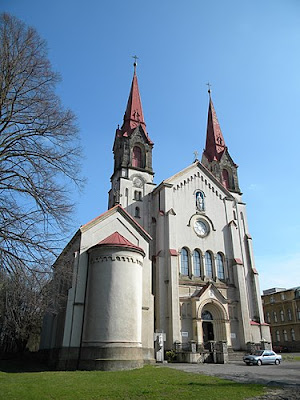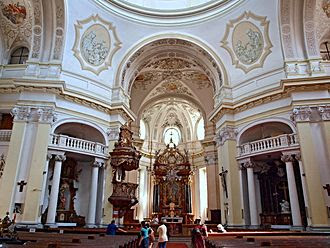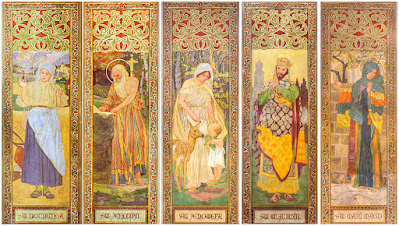Basilicas in Czechia
Basilica of the Assumption of Our Lady, Pribram, Stredocesky
Declared
a minor basilica by Pope Pius X in 1905—the first in Czechia.
The Baroque Basilica sits atop Holy Mountain above Pribram. A chapel was built here in the 15th Century, but after a wooded statue of Our Lady was brought here in the early 17th Century, it became a pilgrimage site. The Jesuits were given charge of the church in 1647 and they built the current Basilica. Since 1861, the Basilica has been served by the Redemptorists. A 365-step stairway leads from the town to the Basilica.
The top picture is from a local source and the bottom picture is from TripAdvisor.
Basilica of Our Lady of Sorrows, Krupka,
Ustecky
Declared
a minor basilica by Pope Pius XI in 1924.
A church has been on this site since 1426 and the current Basilica was built between 1701 and 1722. It is made of stone and built in a Baroque style. The centerpiece of the Basilica is a small clay statue of Our Lady of Sorrows holding the dead Christ. Legend has it that the statue was in a monastery that was attacked by religious dissidents in the early 15th Century who burned the monastery and killed many of the nuns. Some of the nuns escaped with the statue which they hid in a tree. A few years later, a young girl found the statue and pilgrims have come to pray to Our Lady ever since. The statue has survived the Reformation and several wars. The Basilica has seven chapels dedicated to the Seven Sorrows of Mary.
All pictures are from Wikipedia.
Basilica Our Lady Help of Christians,
Jirikov, Ustecky
Declared
a minor basilica by Pope Pius XI in 1926.
The Basilica commemorates a miracle in 1866. The Virgin Mary appeared to a terminally ill 31-year-old Magdalena Kade and told her she was cured, and she was. The Neo-Romanesque Basilica was built between 1873 and 1886 as part of a Redemptorist college and is a major pilgrimage destination in Bohemia. It is literally built on the German border. The Basilica has a 3-foot-high Carrera marble statue of the Virgin Mary.
Both pictures are from Wikipedia.
All Saints Basilica, Ceska Lipa, Liberecky
Declared
a minor basilica by Pope Pius XI in 1927.
The Basilica was originally built as the church for an Augustinian monastery in the 17th Century. A fire destroyed the original church and the current Baroque church was built between 1700 and 1707. There was originally an onion-shaped dome, but it burned in 1820.
Both pictures are from Wikipedia.
Basilica of the Assumption of the Virgin
Mary and Saints Cyril and Methodius, Velehrad, Zlinsky
Declared
a minor basilica by Pope Pius XI in 1928.
Originally part of a 13th Century monastery, the Romanesque and Gothic church was renovated in the 17th and 18th Centuries with a Baroque style. The Basilica has 14 Baroque chapels.
Both pictures are from Wikipedia.
Basilica of St. Margaret of Antioch,
Prague
Declared
a minor basilica by Pope Pius XII in 1948.
The first church on this site was an 11th Century Romanesque building dedicated to St. Adalbert and St. Benedict. It was a Benedictine monastery church and was rebuilt in a Gothic style in the 15th Century and dedicated to St. Margaret of Antioch. The current Baroque church was built in the early 18th Century.
The top picture is from Flickr and the others are from Wikipedia.
Basilica of St. James the Greater, Prague
Declared a minor basilica by Pope Paul VI in 1974.
A
Gothic monastery church was built on this site in the 13th Century,
although a church may have been on the site even earlier. The stone church suffered at least two major
fires as a result of wars and was restored in the 17th Century in a
Baroque style (except for the eastern clock tower which retains the Gothic
style). The Basilica has 22 altars and a
pipe organ with 8,277 pipes. Written
inside the Basilica is a warning from butchers that anyone who threatens the
church will be cut to pieces—twice the butcher’s guild saved the church from
damage. One the parish buildings housed
the first kindergarten in Czechia in 1869.
All pictures are from Wikipedia.
Basilica of the Assumption of the Virgin
Mary, Hostyn, Zlinsky
Declared a minor basilica by Pope John Paul II in 1982.
The
Basilica is a major Marian pilgrimage site in Moravia. The Baroque church was completed in 1747 and
sits atop St. Hostyn hill. The church
fell into disuse and was deconsecrated in 1784 before being restored and
consecrated again in the mid-19th Century. The western façade has a 280 square foot mosaic
of the Madonna completed in 1912.
The top picture is from a local source and the bottom picture is from Wikipedia.
Basilica of the Assumption of the Virgin
Mary, Brno, Jihomoravsky
Declared a minor basilica by Pope John Paul II in 1987.
The
basilica was built in the 14th Century by Queen Eliska Rejcka in a
Gothic style. The church was constructed
mostly with bricks and served as the church for a monastery—originally for
Cistercians, but later for Augustinians.
The interior was restored in a Baroque style in the 18th
Century. The Basilica has a painting of
the Black Madonna brought to Brno in 1356 by King Charles IV of Bohemia. The Black Madonna is the patron of Brno. Gregor Mendel, scientist and an Augustinian
monk, lived and worked near the Basilica in the 19th Century.
All pictures are from Wikipedia.
Basilica of the Assumption of the Virgin
Mary, Prague
Declared a minor basilica by Pope John Paul II in 1991.
The
Basilica was originally built in the 12th Century for a monastery
for the Premonstratensian order. It was
rebuilt between 1258 and 1263 in a Gothic style and between 1601 and 1605 in a
Renaissance style. After suffering war
damage, the church acquired its current Baroque look between 1742 and 1758. St. Norbert, the founder of the
Premonstratensian order is buried in the Basilica. It is said the Mozart played the church’s
pipe organ in 1787, but the pipe organ was later replaced.
The first picture is from a local source and the others are from Wikipedia.
Basilica of the Visitation of the Virgin
Mary, Svaty Kopecek, Olomoucky
Declared a minor basilica by Pope John Paul II in 1995.
A
chapel was constructed on this site in the early 17th Century. It contained a stone relief of the Virgin
Mary and the Baby Jesus, and it quickly became a pilgrimage destination. This chapel was destroyed by the Swedish army
in 1645 and the current church was built in the late 17th and early
18th Centuries in a Baroque style.
The church fell into disrepair in the 19th Century due to a
lack of funds and was damaged in the Second World War. It further deteriorated during Communist
rule. Restoration took place between
1996 and 2020.
All pictures are from Wikipedia.
Basilica of St. Lawrence and St. Zdislava,
Jablonne v Podjestedi, Liberecky
Declared a minor basilica by Pope John Paul II in 1996.
The
stone Baroque Basilica was built for the Dominicans between 1690 and 1711. St. Zdislava was a 13th Century
Czech woman who helped the poor and needy.
She is the patron saint of difficult marriages, and she is buried in the
Basilica.
All pictures are from Wikipedia.
Basilica of the Visitation of the Virgin
Mary, Frydek-Mistek, Moravskoslezsky
Declared a minor basilica by Pope John Paul II in 1999.
The
Baroque Basilica was built between 1740 and 1777 to honor a stone statue of the
Virgin Mary dating possibly to the 17th Century. The church is a regional pilgrimage
destination. The Basilica has eight
chapels and an outdoor Stations of the Cross.
From Wikipedia.
Basilica of St. Peter and Paul, Prague
Declared a minor basilica by Pope John Paul II in 2003.
The
Basilica dates to the 11th Century but has been rebuilt and restored
in different architectural styles through the ages. The current Neo-Gothic design was completed
in the 1880s. It has two 190-foot steeples. The interior is decorated with frescoes and
wall paintings.
All pictures are from Wikipedia.
Basilica of the Assumption of the Virgin
Mary and St. Nicholas, Zdar nad Sazavou, Vysocina
Declared a minor basilica by Pope Benedict XVI in 2009.
The
Basilica was built as a monastery church in the 13th Century and
combines Gothic and Baroque styles.
The first picture is from Flickr, the second from a tourist website, and the last two are from Wikipedia.



































































